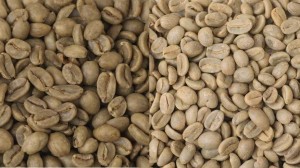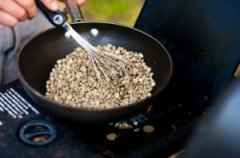The origin and formation of the sour taste of roasted coffee
Raw coffee beans contain sour ingredients such as citric acid, malic acid, quinic acid and phosphoric acid, but these are not the main sources of sour taste when drinking coffee. The acid produced during baking is the main source of sour taste.
Raw beans produce a series of chemical reactions during baking to form new acids. The most important thing is that chlorogenic acid is decomposed into quinic acid, and oligosaccharides are decomposed into formic acid and acetic acid. During the baking process, the sour substances will continue to increase, but as the baking continues, the high temperature will cause these substances to decompose, after a certain stage, continue baking will only reduce the sour taste.
The most acid in roasted coffee beans is quinic acid produced during baking. There are also a lot of other citric acid, acetic acid, phosphoric acid and so on. The strength and concentration of each acid is different, so there is a complicated problem behind the sour taste of coffee.
The sour ingredients and specific gravity of coffee beans are also related to the ingredients contained in raw coffee beans, and what type of coffee beans you choose will also affect the production of sour taste to a certain extent. The content of oligosaccharides in Congo is relatively low, and oligosaccharides are the source of acetic acid, so it can not produce a volatile and refreshing sour taste after baking.
The appearance of sour taste will also be changed by the state of quinic acid. Quinic acid contains ingredients that show sour taste and inhibit sour taste. Brewed coffee will slowly become sour with the decrease of temperature. It is precisely because the ingredients that inhibit sour taste are losing their effectiveness, thus showing more sour taste.

Important Notice :
前街咖啡 FrontStreet Coffee has moved to new addredd:
FrontStreet Coffee Address: 315,Donghua East Road,GuangZhou
Tel:020 38364473
- Prev

Roasting principle of boutique coffee
To put it simply, baking is heating the baking directly. Unlike cooking, you don't need oil, water, salt or sugar to bake. Just put the raw coffee beans in a heat-resistant container, then heat them on the fire, stir the coffee beans constantly while heating, so that each bean is heated evenly, and then stop heating when we reach the desired level.
- Next

Coffee roaster principle of coffee bean roaster
Baking is an esoteric science. To understand the principle of baking, we must first understand the three ways of heat conduction, convection and radiation. Conduction refers to when the heat is transmitted by the heat source, causing the surrounding molecules to vibrate and release heat, gradually moving from the high temperature to the low temperature. The conduction of stainless steel has the phenomenon of uneven heating, which can easily lead to colder and hotter parts of the pot.
Related
- Beginners will see the "Coffee pull flower" guide!
- What is the difference between ice blog purified milk and ordinary milk coffee?
- Why is the Philippines the largest producer of crops in Liberia?
- For coffee extraction, should the fine powder be retained?
- How does extracted espresso fill pressed powder? How much strength does it take to press the powder?
- How to make jasmine cold extract coffee? Is the jasmine + latte good?
- Will this little toy really make the coffee taste better? How does Lily Drip affect coffee extraction?
- Will the action of slapping the filter cup also affect coffee extraction?
- What's the difference between powder-to-water ratio and powder-to-liquid ratio?
- What is the Ethiopian local species? What does it have to do with Heirloom native species?

